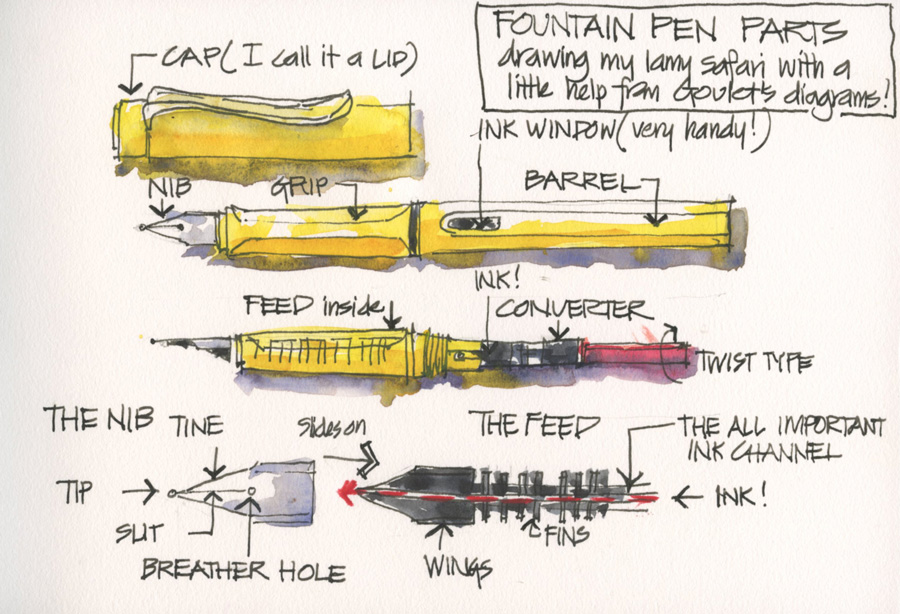
Part 3 of my current series on Fountain Pen Sketching contains a summary of what I believe are the basics you need to know to use your fountain pen for sketching. There is a lot that I am not going to be able to cover, so I have provided plenty of links to Goulet videos where you can get the full details. I will also be sharing a few personal preferences in the way I use and look after my pens – some of my pens get a lot of use and rough treatment, while others get filled up with a random coloured ink and are then forgotten.
I have learnt a lot as a result of putting this together, with the help of Madigan from Goulet Pens who has been amazing, answering all my detailed questions – thanks! If you have any specific questions please email the Goulet team for advice. If you haven’t watched the first four videos of Brain Goulet’s Fountain Pen 101 series I recommend that you do at some stage.The above sketch describes the most important parts of a fountain pen, but if you want the full glossary please check out the Goluet Anatomy of a Fountain Pen page.
WARNING: This is a very long post but I wanted to put all this basic information together so that you will have a single point for reference in the future. You can always come back and explore the links on another occasion! So, go and make yourself a cup of tea or coffee and let’s get going.
- Holding your pen – and drawing with it!
- Line Variation
- Posting (the cap)
- Paper
- Ink Storage System
- Ink – Permanent Inks for Fountain Pens
- Refilling your pen with ink
- Pen Maintenance
- Storing your pen/s
- Common Questions
1. Holding your pen – and drawing with it!
As I mentioned in Part 2, a fountain pen needs to be held in a different way from a fineliner and also from a ballpoint pen. The common use of ballpoint pens for writing in our day and age means that changing your grip to suit a fountain pen can be a major adjustment.
It is important to realise that fountain pens are designed to be used at a 45 degree angle with the nib straight on the page (ie don’t rotate the pen as you write or draw). They are designed so that the liquid ink flows out easily – they don’t need the pressure that most ballpoint writers use. This means you can hold it more loosely which has many benefits for your sketching. You might also want to try adjusting your grip further back on the pen when you need draw a line with your shoulder rather than just your wrist – such as an ellipse or a long straight line. When you want to do careful detail you will probably change the pen angle to more vertical.
Fountain pens work best when you pull them, rather than push and this is one of the major things that worry left-handers. Refer to the link below for more details. However I believe that drawing with a fountain pen is less problematic than writing as you can draw your lines in whatever direction you want – I always draw my lines from right to left.
You will also want to think about changing your grip to suit lines going in different directions when ..but that leads me on to the next section.
Some more Goulet videos for further details:
How do you hold a fountain pen?
Fountain Pens for Lefties
2. Line Variation
One of hottest topics in the sketching world is how to achieve line variation in a fountain pen similar to that with a dip pen – generally the greater variation the better. Whether this is from a calligraphy nib or a nib that flexes, the search is on for the best out there. This can make entry into the fountain pen world a little overwhelming, so I only want to mention a ‘basic pen’ at the moment.
You don’t need a fancy pen to get line variation, any fountain pen will give you options for a thin, medium or thick line. It won’t be as great a variation as with a calligraphy or flex nib, but it will be more than what you can get a single fineliner. Your normal light pressure line represent the medium line. By applying more pressure on a downward stroke you will get a thicker line, and by turning you nib upside down you will get a lighter line.
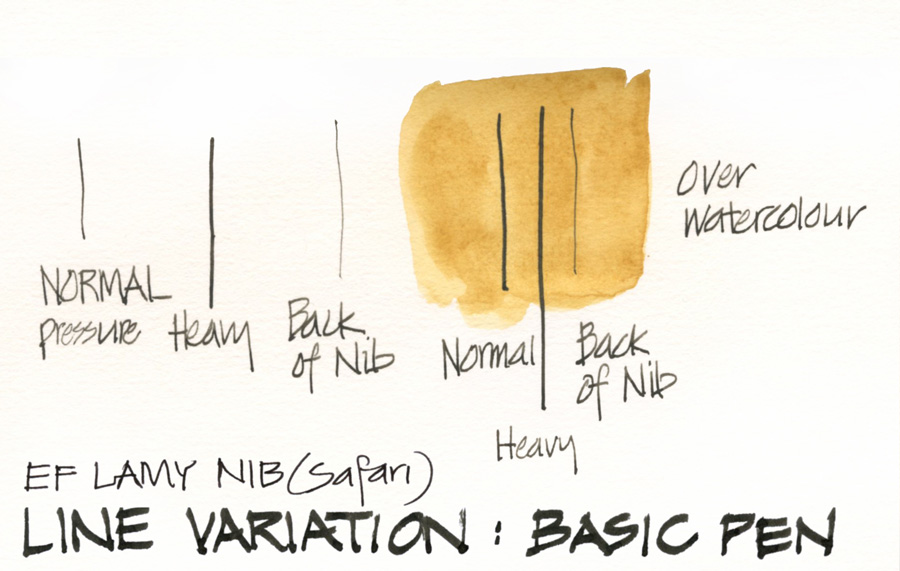
Here are some variations from a fairly new Lamy steel nib and you can see how much variation I can achieve. (Note: It is not fair to do tests with the much loved and worn in gold nib of my White Joy as it works differently from any new nib that you can buy)
On the right I have done some tests with drawing over dried watercolour paint and you will notice that the ink bleeds slightly resulting in a thicker line. This can be a bit of a hassle if you need to add lines after you have started painting, so turning the nib over and draw a thinner line can prevent these additional lines from having a different thickness. However this bleeding can be used intentionally to create a thicker line than you can normally achieve with your pen!
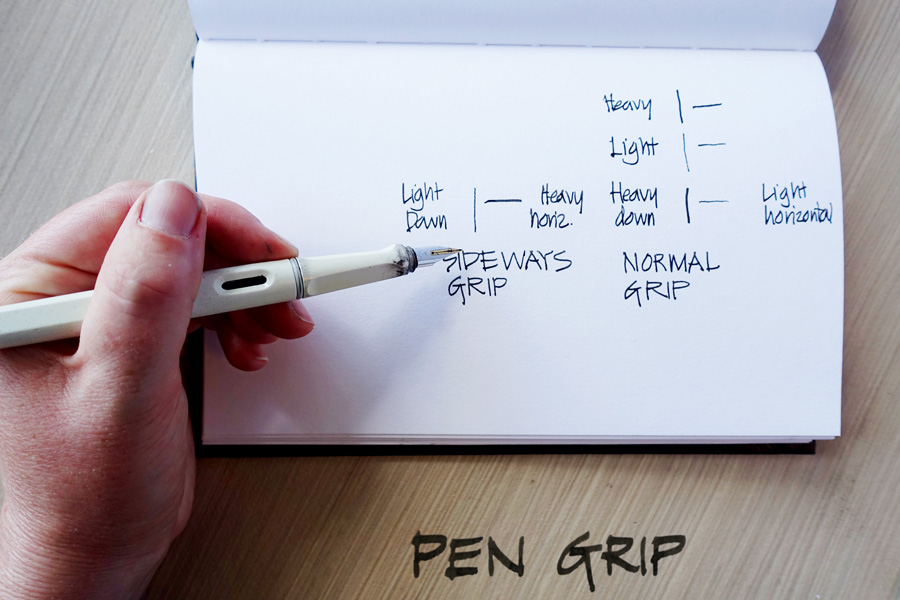
Using a normal grip you will be able to get the heaviest lines by applying pressure on a downwards stroke and the lightest lines (without turning the nib over) by using light pressure with a horizontal stroke.
Because you will be drawing lines in all kinds of directions, to get the most of the line variation, it is good to develop a sideways grips so that you can pull your pen in horizontally with a good pressure to get a nice thick line. Don’t forget to rotate your sketchbook to help get the lines you want!
3. Posting (the cap)
In some ways this seems like a strange aspect to highlight but you will be surprised at the implications when you sketch. Obviously most pens as designed to ‘post’ the cap on the back when you use them – but there is no rule saying that you must do so. If the pen feels better in your hand without the cap on, don’t put it on.
Starting from the top:
- I normally post the cap when I use a Lamy Safari.
- However I never post the cap to the Lamy Joy. My White Joy is unposted and the Black Joy has the cap on the end. For me the balance of the pen is perfect without the cap so I normally hold it in my other hand.
- The cap of the Platinum Carbon Desk Pen does not post at all but a few sketchers have just chopped the end of the pen off so that it does.
- The Kaweco Sport is a little short without the cap so it is important to make the length of the pen more usable.
- The Hero M86 becomes a weird shape with the lid – take you pick. I prefer to use it unposted.
Have I ever lost a lid? No never! (this is quite an achievement as I have lost two fountain pens and 1 paint tin over the last 5 years)
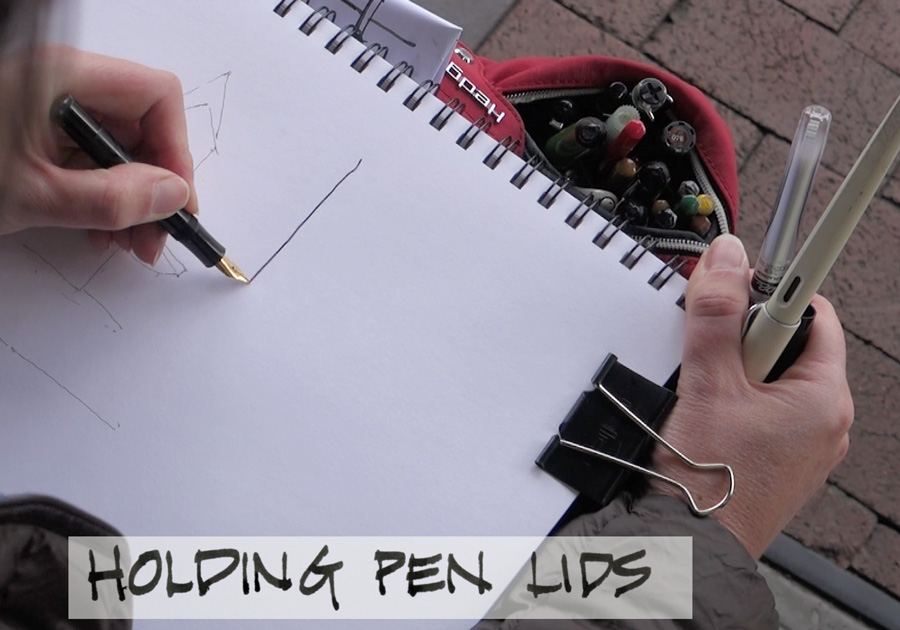
In fact, when I use multiple pens I use all my pens unposted (even the Kaweco Sport) and hold the caps in my right hand for easy swapping between them. This image is a still from my SketchingNow Edges online class where we looked at line variation in lesson 3.
Note: I will be looking at these pens in more detail in Parts 5-7 so please wait till then for questions – ok?
4. Paper
Paper is a huge subject, worthy of a series on its own but here are a few thoughts.
Fountain pens work best on smooth paper (like Rhodia and Clarie Fontaine) and watercolour is easiest on textured paper, so inherently sketching with ink and wash will involve some form of compromise. It is up to you to decide to which side you want to lean in order to achieve a happy medium between the two. It is interesting that I have generally chosen paper that feels good for my pen and have compromised a little on the watercolour side of the equation!
That being said I have not had any problems with most of my pens on a huge range of sketchbooks/ watercolour paper. Ones that I have used without any trouble are:
Moleskine watercolour, all Stillman and Birn range, Handbook travelogue watercolour paper, Pentalic Aqua, Daler & Rowney Ebony, Fabriano Artistico, Fluid and many more.
To date my only issues have been:
I have found Arches abrasive and that De Atramentis ink bleeds on the paper in the Fabriano Venezia sketchbooks.
Some advice if you find your pen struggling with your chosen watercolour paper:
- Clean your pen (water or pen flush – see below) and possibly even floss your nib if there is a build-up of paper fibres in your nib.
- If you are not getting a good flow, you can also try a wetter ink (such as De Atramentis), draw slower or try a slightly thicker nib (a Fine rather than an EF).
- If your ink is bleeding, then try another ink and go to a finer (EF) nib.
- I would also suggest that you test your pen on smoother paper to work out whether the problem is the pen or the paper.
5. Ink Storage System
Ah! let’s start talking about ink. For starters, there are a number of different ways that a fountain pen can store ink. Please refer to the video below for more description. My comments below are specific to sketching and for permanent ink use.
- Cartridge: The most common way (and by far the most convenient) is in a cartridge – but most ink cartridges are water soluble and not suitable if you want to do traditional ink and wash. However there is one permanent ink cartridge on the market: Platnium Carbon Black Ink. This is very exciting but limits your pen selection to those in the Platnium range (more about this in Parts 4 and 5!)
- Converter: Most pens have the option of a converter (sometimes included) which means you can fill up your pen with any ink you like. The only disadvantage with converters is that they don’t have a large capacity.
- Refilling a cartridge: An alternative (that I am using more and more these days)is to empty a proprietary cartridge of the original ink and then refill it with the ink of your choice.
- Piston: If you are after a large capacity of ink then a piston pen might be the way to go – using the whole barrel of the pen like a converter. But just make sure that you use your pen regularly and don’t let it sit with unused pigmented ink for too long.
- Eyedropper: And the greatest capacity of the lot is to do an eyedropper conversion to a pen. I recently converted this Platnium Preppy pen to eyedropper and it is amazing how much ink it holds. If you are interested in doing this look through the Goulet Q&A slices for a number of videos on this topic. Note: I am a little nervous abut this option especially with my usual rough treatment of sketching pens out on location.
Goulet Videos:
Ink FillingMechanisms
Cartridges
6. Ink – Permanent Inks for Fountain Pens
VERY IMPORTANT NOTE: Most permanent inks are not designed to be put into fountain pens as the pigments and other ingredients can totally clog up and ruin the feed of the fountain pen. However the four brands of ink listed below have been designed for fountain pens and contain finely ground pigments. But these can still clog your pen so “use at your own risk” and make sure that you don’t leave your pens lying around unused with ink in them for long periods of time. (More about pen maintenance below). Do not put these inks into any vintage pens without doing your own research on suitability.
That being said, I have used these inks with great success and have hardly had a problem over the last 8 years.
The four most popular brands of Permanent Ink are
- Platnium Carbon Ink. I have only recently started testing this ink but I know that many sketchers use it and are very happy with it. And as mentioned above they come in cartridges!
- De Atramentis Document Ink (please note: it is the Document ink range only that is permanent). This is the ink that I love to use. It flows wonderfully and comes in a range of colours – in fact they specifically designed a set so that we could mix any colour we want. I just love drawing with different coloured inks – you can see some of my sketches and blog posts here.
- Super 5. They come in a range of five different colours and are good fast drying permanent inks. I haven’t used them extensively but in my limited testing found them to dry out in the pen quicker than De Atramentis
- Noodlers Bulletproof or Polar range of inks. These were the first permanent inks I was introduced to and used without any problems for many years. Other people have had a problems with clogging pens (particularly Lamys) and the ink smearing when applying paint over the top but I rarely had any problems with it. There are many theories that have circulated online (such as ‘Noodlers doesn’t work for Moleskine paper’) but my own experience was different from many of those theories – there are so many variables when using fountain pens for sketching. Lexington Grey (a beautiful colour) is generally considered to be the best performing of the Noodlers inks.
Note: Goulet pens offer ink samples and a swab shop for comparing inks! They have recently added De Atramentis Document Ink sample kit to their collection so check it out.
7. Refilling your pen with ink
The best thing to do is to watch Brian’s videos! This one shows filling a pen with converter (the first two minutes show what I normally do).
As mentioned above, I am moving away from using converters to filling up empty cartridges using a ‘pen syringe’ – a syringe with a ‘pipette’ attachment. More in Brian’s video here. This is the quickest, cleanest and most efficient (less air) method of filling that I now often fill up my converter using a syringe as well. It also prevents me from putting my (already grubby) white pen inside the ink bottle.
I am a ‘heavy user’ and normally check the ink level of my Lamy every few days. I now have an innate feeling for how much ink I have used since last fill up and rarely run out of ink when I am out and about… hmm, in fact I had better go and check it now!
8. Pen Maintenance
Ok, this is the topic that I suspect puts people off fountain pens… but come on, you don’t put off starting watercolour just because you have to wash your brushes, do you? (I am being cheeky I know!) So here is the video to watch.
To be totally honest I haven’t been very regular with cleaning of my pens. I have been living dangerously for far too long but am now a changed person and I am excited to be doing the right thing for my pens finally!
Goulet kindly sent my some of their pen flush as part of their pen cleaning set and my pens are getting special treatment these days – this stuff is great! Here is Brian’s Tutorial for using their pen flush. It certainly cleaned out some of my problem pens amazingly well (problem pen = ones that were clogged from sitting full of ink for way too long). If you want to make you own check out this video.
One more video I came across…
After Flushing the Pen is it Ok to Fill it up with Ink Immediately?
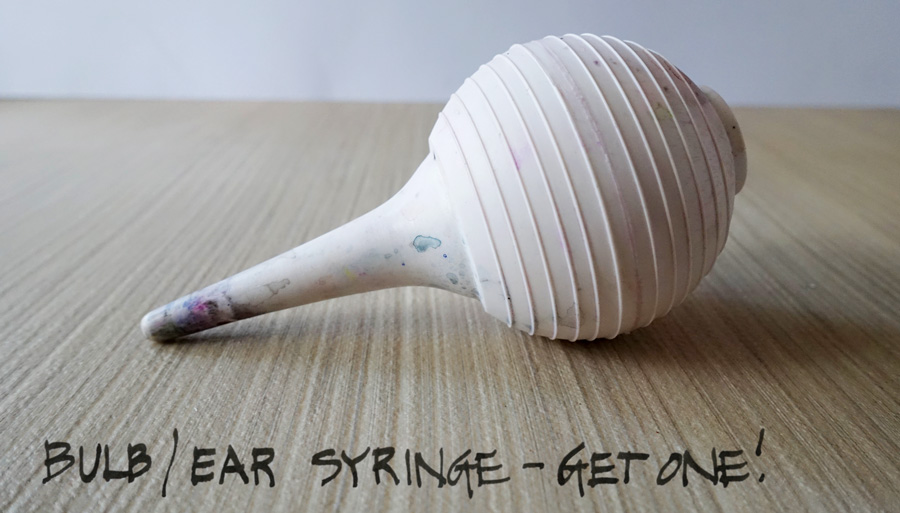
Seriously – this is the most exciting pen accessory on the planet! Go get one this week!! – most pharmacies/drug stores would have one and you can buy one from Goulet here…and there is a video as well.

I can’t tell you how easy it makes it to clean your pen… to the point that I am now becoming obsessed with flushing the feeds of all my pens regularly. I just had to take these photos to show you how easy it is… only takes seconds! Oh! I love this! (I can’t believe I just wrote I love a bulb syringe…but I do – it is the best!)
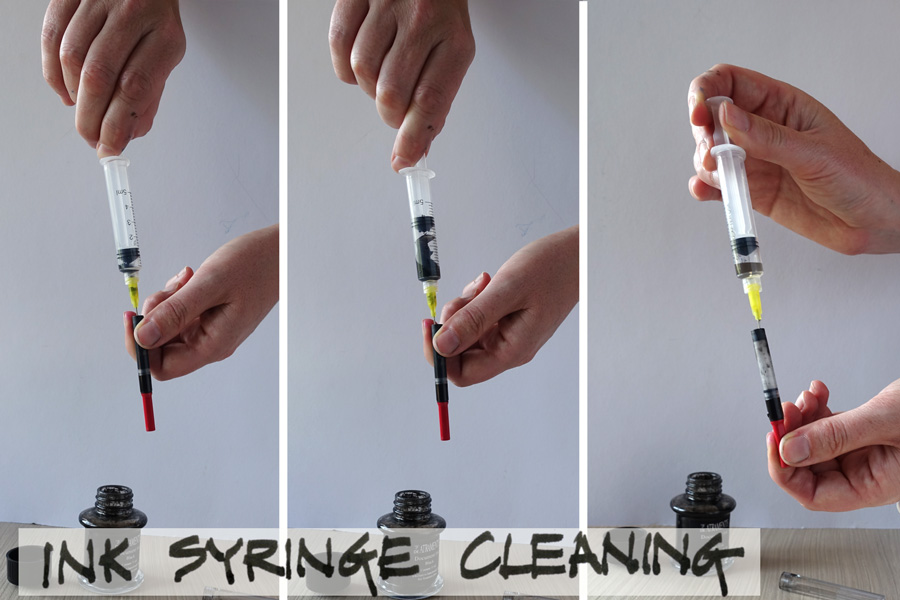
I also an now using my pen syringe to suck out the ink from cartridges and converters. I find the rapid up and down movement much easier and quicker than the twisting up and down of a converter (as shown in the above video).
My proposed new cleaning strategy (which might become its own post once I have perfected it):
1. Flush the feeds of my pens at the end of the week and store the ‘occasional use’ ones vertically.
2. Once a month I will review my ‘occasional use’ pens and if I haven’t used them for a few weeks, totally clean them out.
9. Storing your pen/s
Check out this video here. I haven’t been doing anything fancy (just a plastic container) but after the proposed TLC my pens are going to receive from now on, I might have to review that. Oh no… can you see I am in danger of buying a fancy pen case?
If you have been following my blog for the last 12 months you will notice that I often use a lot of different pens filled with different inks. How do I remember what ink is in what pen? Ha! my blog posts such as this one helps... but honestly I do forget. I have been thinking of elaborate schedules for keeping track of it all, but have since realised that cleaning out my pens regularly is the best solution! I don’t have to remember AND there is no danger of the permanent ink drying and clogging my pens. Its a win win! I think that I might have to invest in a few vials and one of Goulet sample vial holder as I do mix up a few unique coloured inks. Oh dear – doing this series of blog posts is dangerous for me too!
Ok, I know this has been a marathon but just a few more points and I am done….(till Part 4 anyway!)
10. Common Questions
I get asked for pen advice all the time and the common complaints are:
‘my pen is scratchy’ or ‘my pen is not flowing well’
So here are a few ideas – but please ask the Goulet team – they are the experts, not me!
- Clean the pen! Initially with water and if that doesn’t help then use a pen flush. Refer to links above in Pen Maintenance sections
- Try writing with your pen on smooth paper (rather than textured watercolour paper) to get the ink flowing and to see if it is still skipping
- Make sure you are using the nib straight on to the paper and not rotating the pen as you write/draw. Video about italic nibs but some good comments about pen rotation.
- Try a wetter ink such as De Atramentis. I had a few pens that didn’t work well with Noodlers but as soon as I put DeA in they started flowing beautifully.
- If the pen is scratchy you might need to align the nibs. More here (you don’t need the fancy loupe -can use any magnifying glass).
- Floss your nib using a brass sheet to clean out the paper fibres
And the other common question is “can you take your pens on a plane?”
And yes, your pens can leak when flying but with a few precautions it isn’t such a big deal. My thoughts , Brian Goulets video on the topic and his practical experiment trying to get his pens to leak. Honestly, it has been a total non-issue for me – I rarely have my pens vertical and am normally sketching on takeoff (the time that Brian recommends not to use your pen!)
So there you have it! That’s all you need to know about fountain pens – to get started anyway!
As always I love hearing from you all… more tips and questions. And just for the record Part 4 will be a lot simpler – I promise!
If you missed it
Click here for Part 2: Why draw with a fountain pen?
Up next…
Part 4: Choosing a fountain pen
Once you have a fountain pen you will have to start drawing with it!
If you would like to learn the fundamentals and start urban sketching please check out my Foundations online course.
Subscribe to my mailing list for my monthly newsletters for first news of new courses and face to face workshops in Australia (and overseas!)

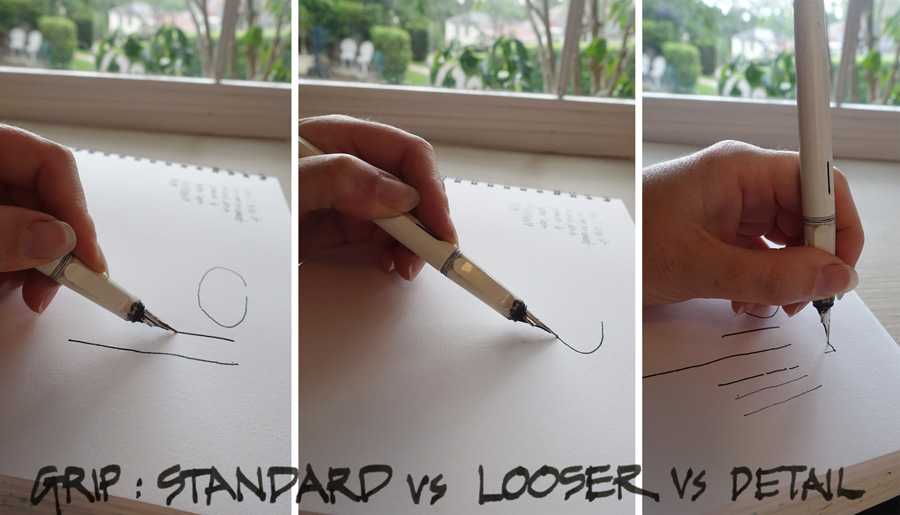
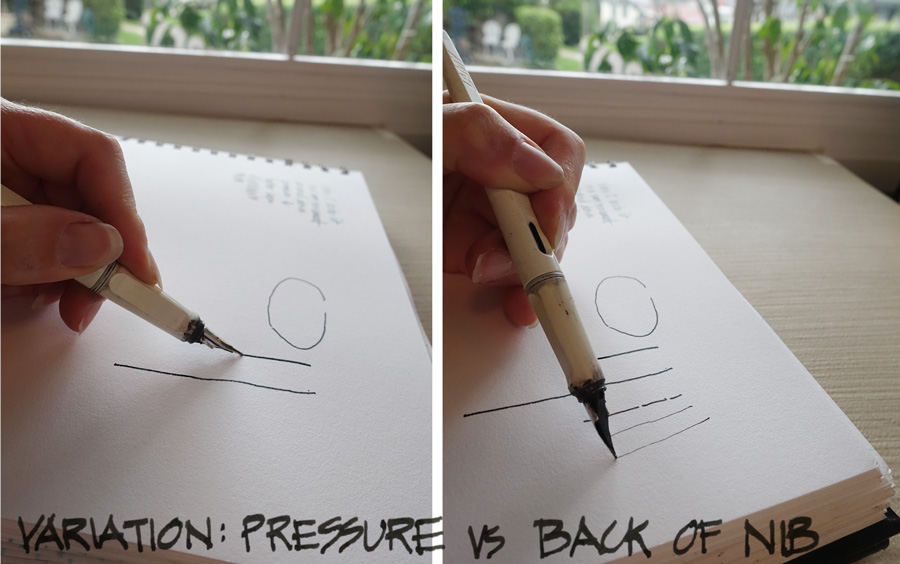
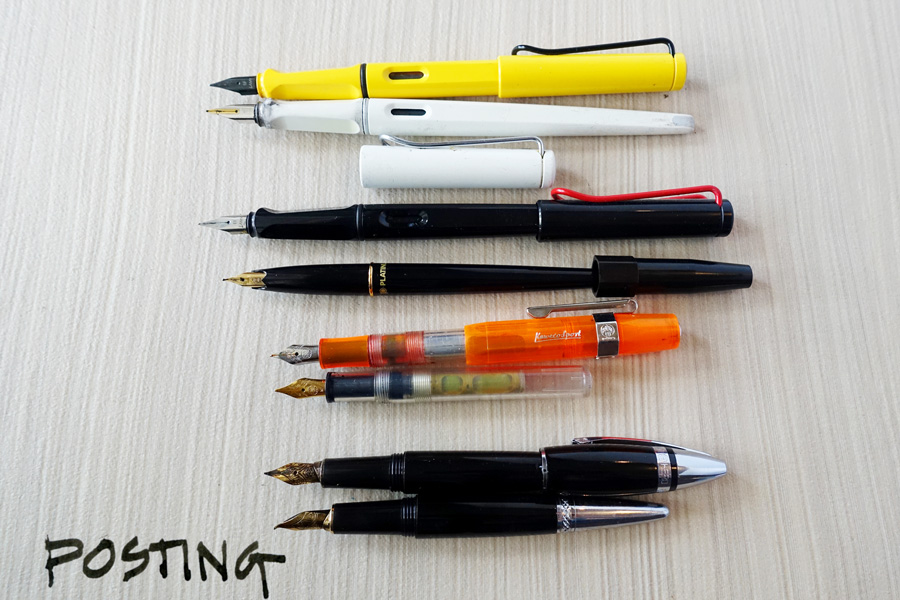
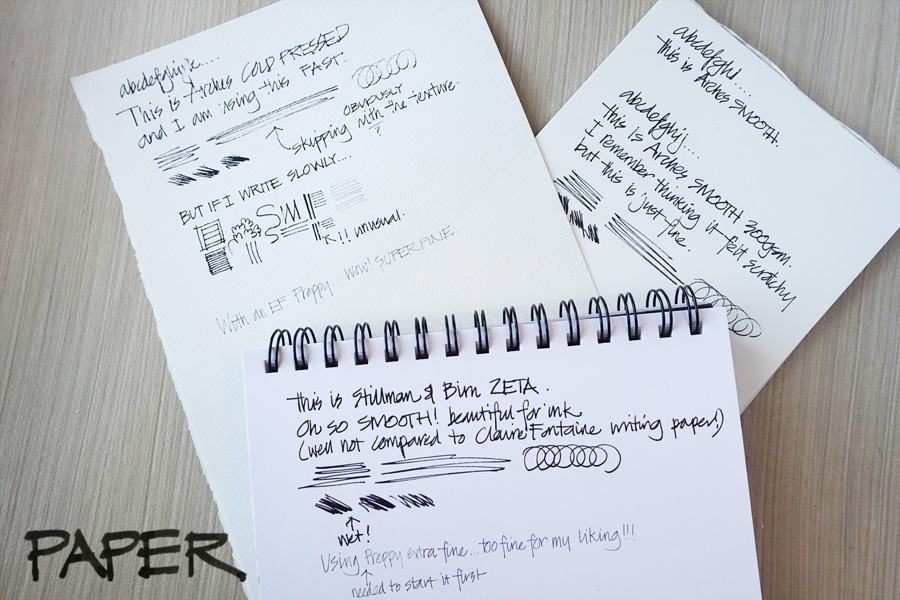
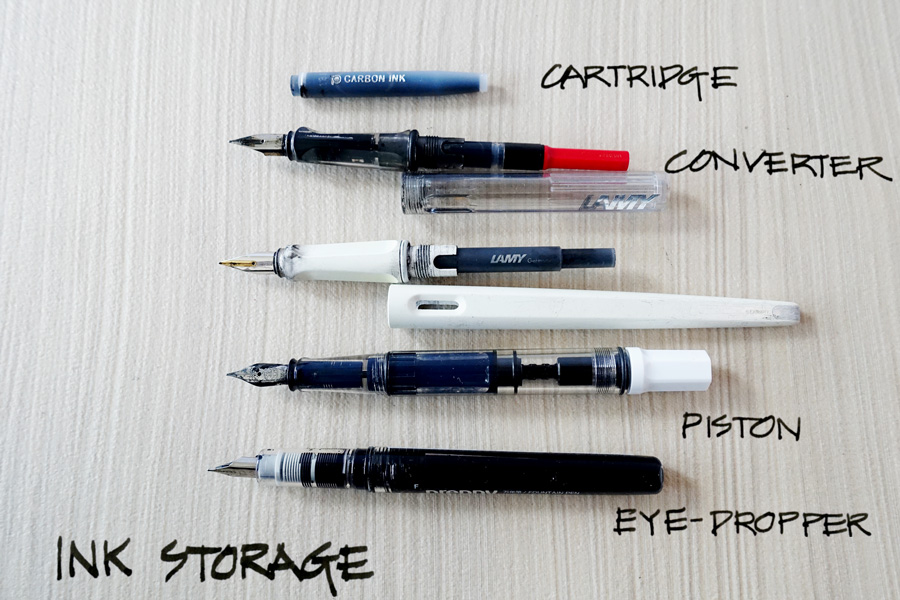
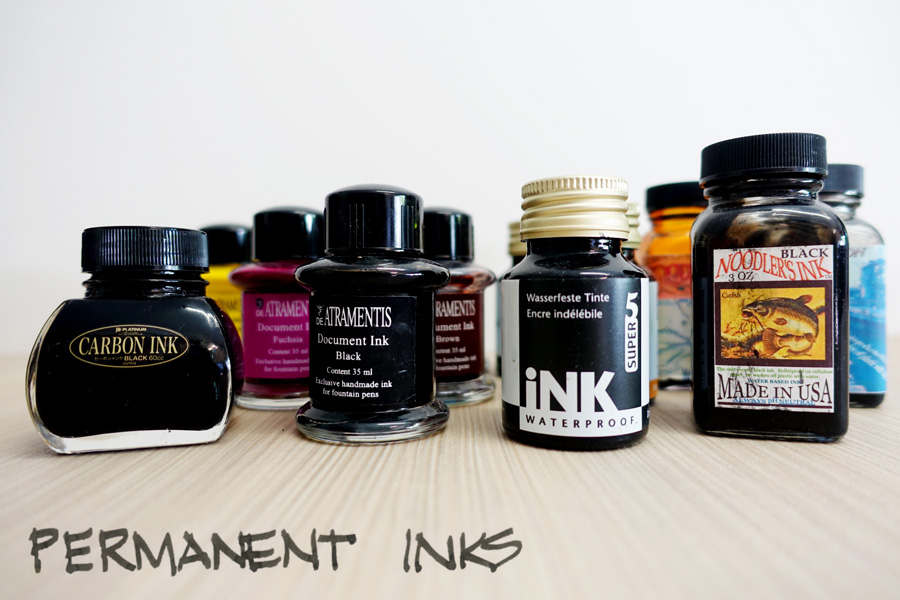
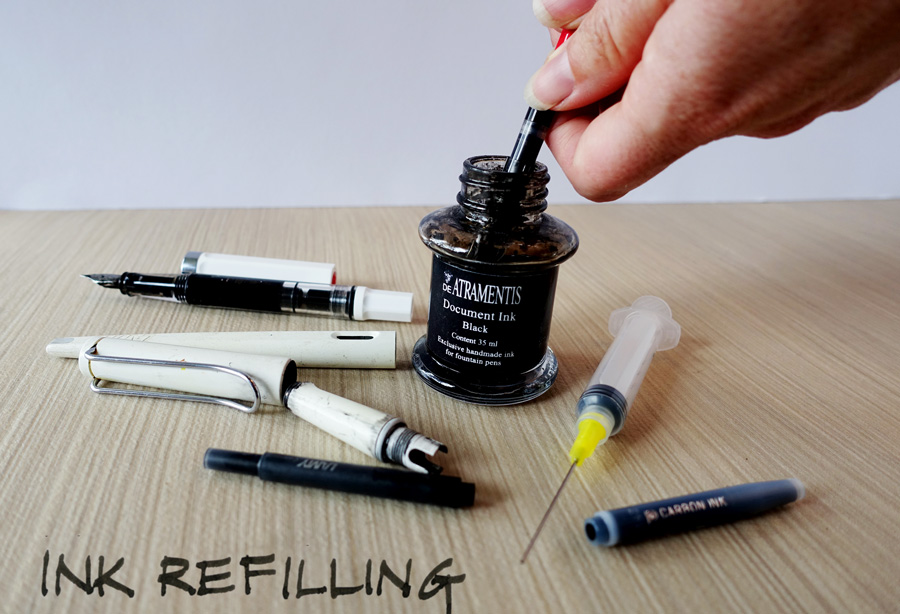
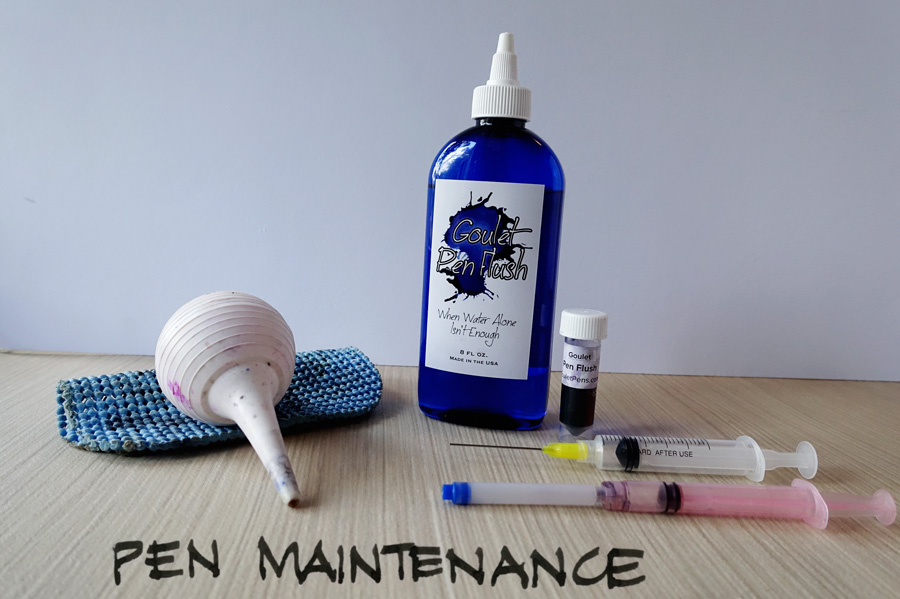
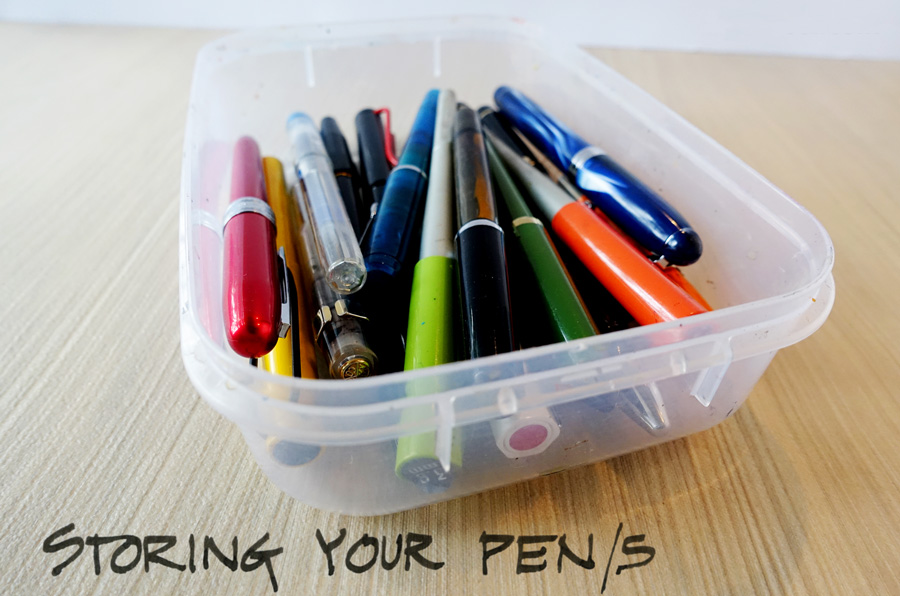




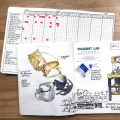
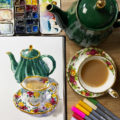
32 Comments
I use a label maker to designate the ink in a pen. They peel off. I even put my name and phone number on my TWSBIs and Falcon. You can get carried away with a label maker!
Well wow. This was terrific, Liz, thank you so much!
Yes, fantastic going to be coming back and watching all of these videos. First..more coffee….
Thanks so much for these excellent posts on fountain pens! I mostly use Lamy Safaris for sketching and have had no problems with Noodlers Ink clogging them. Lexington Grey is my favorite for sketching and seems waterproof to me when I go back over it with watercolor. I also like using non waterproof Noodler's inks and then going back with a Niji Waterbrush filled with water to make shading. I plan to try the De Atramentis brand next. I love the color you refer to as Raw Sienna. Is that a color from a particular brand? thanks again for sharing your expertise.
My favorite choice is Rohrer&Klingner-permanent ink in Lamy`s fountainpens. Sepia, ochre and violett is what I used and they all worked without problems also when I mixed them. As we had a very hot summer here in Germany I added some water now and then and Lamys of diffrent Nib-Types went on drawing unimpressed of the wheather.
Thank you Liz – it's worth to look around in the wonderful fountainpen's world!
Another fantastic post, Liz. I've had partial blog posts headed in this direction for a very long time but I guess I was just too lazy to write the series you're writing. Sketchers need fountain pen advice from sketchers, not writers.
You mention that you have been "living dangerously for far too long" when talking about cleaning fountain pens. Sometimes, experience teaches that common wisdom is simply not true. I think this is one of those times. I've been using fountain pens for decades and the only time I clean a fountain pen is when I'm switching inks or putting it away for storage. I just keep stuffing more and more DeAtramentis into my drawing pens and they, in kind, continue working. One thing we have to keep in mind is that most of the people giving fountain pen advice are pen hobbyists…it's what they do for fun, and the constant cleaning is part of that fun. For the rest of us…not so sure. For what it's worth, I think it was the last video that Brian Goulet did where he admitted that he doesn't clean his pens as often as he recommends 🙂
I think your idea about holding your caps in your hand so you can use them as receptacles for your pens when using multiples is a great idea. I REALLY hate having a pen that doesn't work well when posted because I have lost a pen cap while sketching. In my view, the Lamy pens are way too tail heavy when posted, which is one of the many reasons I don't use them. But more and more I'm working with two pens at once and your idea is one I'll probably adopt.
I am also thrilled that you spent so much time talking about all the line variation you can get from a standard, steel nib. I find the 'flex nib' hype in the sketching community is way overblown. One of those partial blog posts I eluded to is about flex. I present a Liz Steel and Marc Taro Holmes and ask whether those sketches have enough line variation, which they obviously do and then point out that they're being done with standard, steel nibs. Good on ya for making that point. — Larry
It is a bit tragic isn't it???? So glad you are enjoying the series!
thanks Simone – will have to look those up! And well done you, for sketching in the hot weather!
my pleasure Linda!
thanks Patricia – more about the ink here
https://lizsteel.com/2014/12/coloured-ink-mixing-raw-sienna-with-de.html
Ah! label maker… I have that on a 'maybe one day' list (from David Allen's Getting Things Done book)!!! Don't tempt me!!!
Yay! you might new a lot of cofee to get through all the links videos!
thanks Larry! And you are certainly not lazy… I have been putting this off for ages as I knew it would be a lot of work. SO great to be able to do this… and get other peoples feedback as well.
I don't clean my regularly used pens much at all (much less of an issue when the ink is flowing) – it is the ones that I haven't touch for a few months that I am going to be stricter with! But honestly the bulb syringe is SO easy and quick that I will at least keep my feeds cleaner.
Let me know how you go with holding the caps – works really well for me!
And yes, I agree that the flex discussion can get a little overblown at times. BTW the metropolitan is going to get a great review in Part 5!
Ah! if you are using your pen all the time and the ink is flowing I think it is much less of an issue. So agree with you and Larry. I cleaned my White Joy only about once a year and it worked fine… but always SO much nicer after a clean. Sadly many people let a pen sit for months untouched and wonder why it doesn't start immediately. So I suppose one has to err on the side of safety when making public guidelines….
Li z thank you for this wonderful series enjoying a lot,
Love your enthusiasm for the ear syringe! Thanks for taking the time to give a thorough overview– I've enjoyed it!
my pleasure Kate!
Great post, Liz — very helpful. I agree with Larry, above — cleaning is over-rated. ???? I often refill a pen with more Platinum Carbon (or whatever ink it already contained) several times without flushing and have had no ill effects.
Tina
Wonderful – now I know what colors to order! Thanks so much, Liz!
oops…as you hadn't mentioned it, I just gave a plug for the Metropolitan in a comment to part four.
I think you're right, Liz, about why there's so much emphasis placed on cleaning by pen whisperers…insurance for the speaker. I think it's the same reason there's so much "be careful" stuff associated with Platinum Carbon Black (and now DeAtramentis Document) ink(s). I've gone through a lot of PCB and DAD and I have no more trouble with those inks than any other, but the warnings are still being handed out in bold-face 🙂 I've noticed that you haven't made a big deal about this..more applauding 🙂
Thanks for your posts, Liz. I have been using Lamy fountain pens (both Joy and Safari), but only with ink cartridges. Your posts have encouraged me to try using ink converters, rather than only cartridges. There are many more interesting colors to choose from. Thanks.
Can I point out that if (/ike me) you unconsciously chew and bite the end of your fountain pen, you may find the metal-bodied Lamy Al-Star pen survives in one piece unlike the Lamy Safari, and performs much the same. They are really light still, and the irridescent metallic colours are just magic too! I use mine for writing as well, with De Artramentis document Ink. Thanks so much Liz for this brilliant guide in how to care for and prolong the lives of our beloved fountain pens: Ear Syringes sound like an absolute essential.
Hi Liz,
I have to say I’m becoming a bit obsessed with your site (started the watercolor class as well). I bought two pens after reading your extensive posts and I can’t be happier. I have a Pilot Metropolitan with Noodler’s Ink in Lexington Gray which I use for all my sketching now. I have large hands and i find the weight of the metro feels really comfortable. I love the ink and I find it’s really wet but dries truly bulletproof and I can paint over it almost instantly. I love the toned down gray as opposed to my usual black micron pens. I also have a Pilot Kakuna with Noodler’s ink in Blue Nose Bear for writing in my sketchbooks. You were right on about this little pen and for $10 it is a workhorse and the fine nib is such a pleasure to write and draw with. And the BNB It’s such a great funky dark turquoise. I just love it.
I make it a habit to use the pens every day as I know Noodler’s can cause issues if left to it’s own devices. Thanks so much for your in depth research and ability to get information to the masses in a concise way.
I saw De Atramentis Document Ink cartridges online; what kind of pen would be best to use with these? Do Lamy pens use a different, proprietary sized cartridge?
Hi Marjorie – this article lists a few pens that suit those cartiridges
https://www.lizsteel.com/de-atramentis-cartridges/
Thank you, that’s a lot of help. I also got the Goulet random sample inks and it has been fun. The little plastic ink bottles can also be refilled and used to store ink when you are traveling.
Late to the comment party but I don’t think cleaning is overrated. Especially if you use permanent ink and/or treasure the pen!
I’ve fountain pens that were gifted, very old, impossible to find parts for. I have also left some with ink in them until they dried up. Because they never dried up with the ink I mainly use (Parker Penman Sapphire).
If used daily/weekly you’re probably fine not to clean as often.
In the case of my pens (with solid gold nibs that a nib Meister must service because can’t disassemble the nib from the feed, very old) I store empty. After a good flush. When gunked up badly the only option given was if the ultrasonic cleaner won’t help after a 24hr lukewarm soak then a full restore may not have much luck. (The feed is fully blocked or destroyed. Ooof.) Lesson learned! The pen is fine btw.
I use a cheap ultrasonic jewelry cleaner (50 bucks thanks Aldi) because a bulb flush doesn’t get everything. Water only. But I also use metallic inks for fountain pens. (And yes one of those gold nibs and converters is reserved only for metallic ink. It’s a beautiful pen that writes like a dream. A gift from an elderly family member- I treasure both.)
But I also ultrasonic every part separately. I’d never use the ultrasonic on gold plated nibs. Steel or solid gold it’s fine. I’ve not bothered with my Preras, TWSBIs or Platinum Preppys at all and they’re used at least weekly… They are at least a couple years old now? If they start to skip then yes I will.
You can use cloudy ammonia with a water soak (no stronger than 10% ammonia to water mix) without issues providing you rinse well with clean water apparently. I’ve never used a commercial pen flush- the nib Meister was cranky enough already at my fountain pen abuse before I suggested using one XD
Thanks for sharing Skint Student!
NEWSLETTER
Subscribe for first notification of workshop + online classes and more.